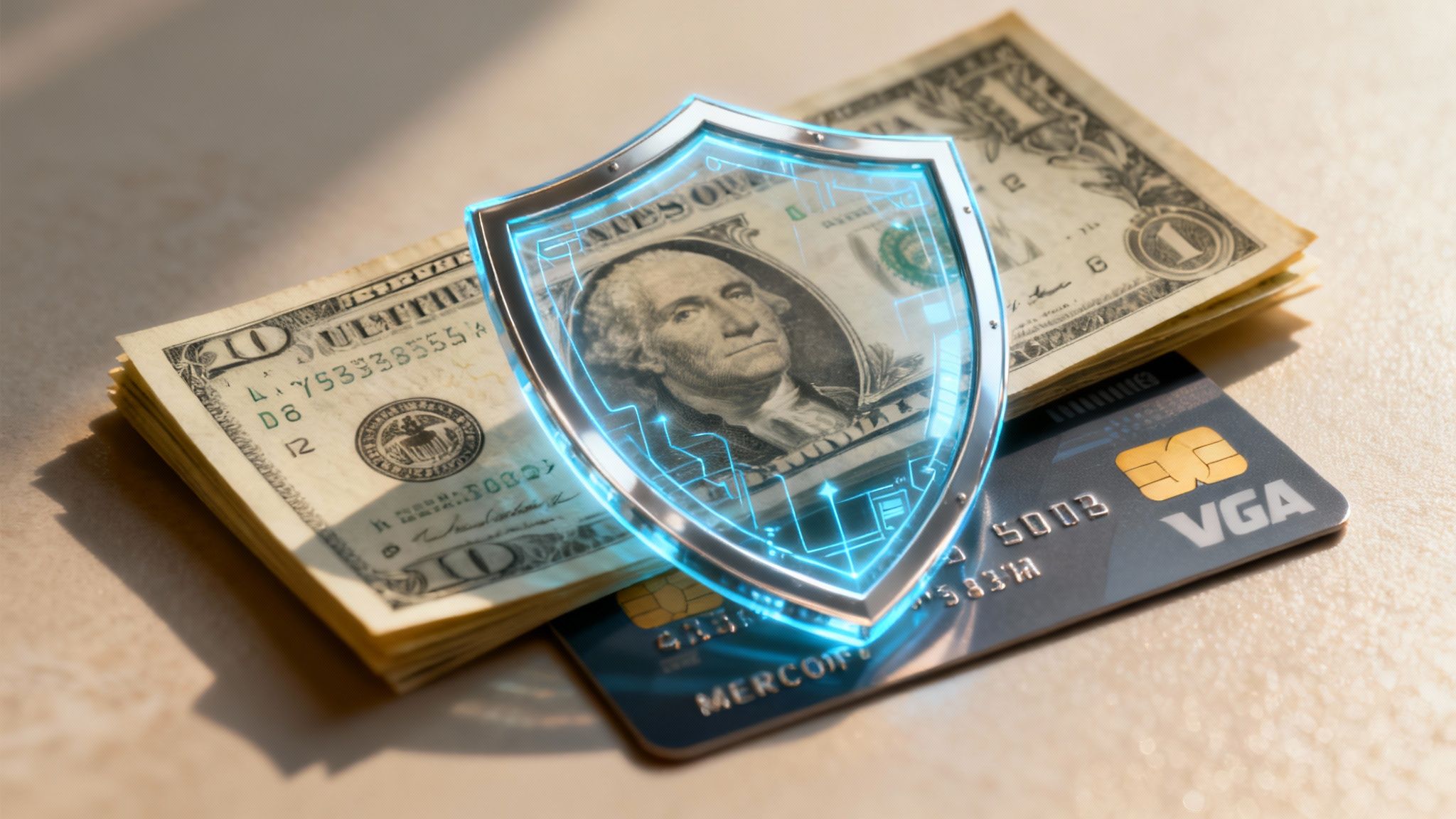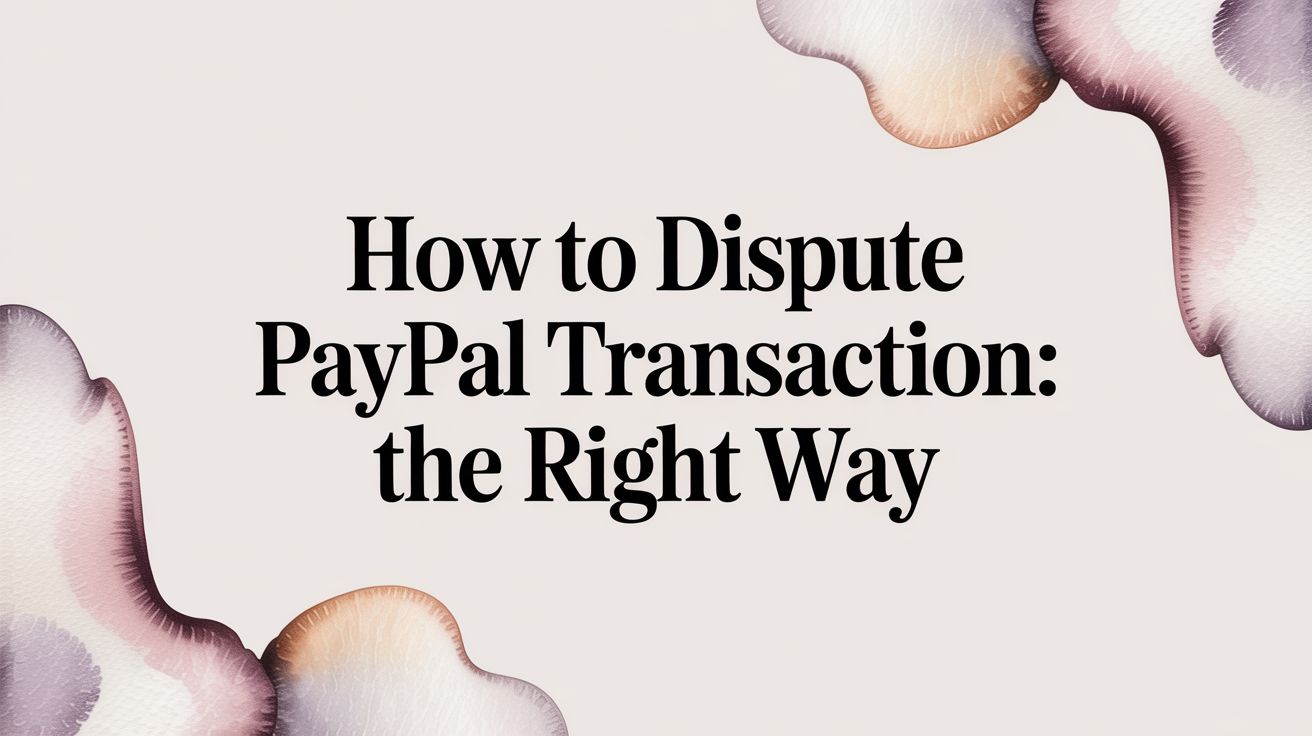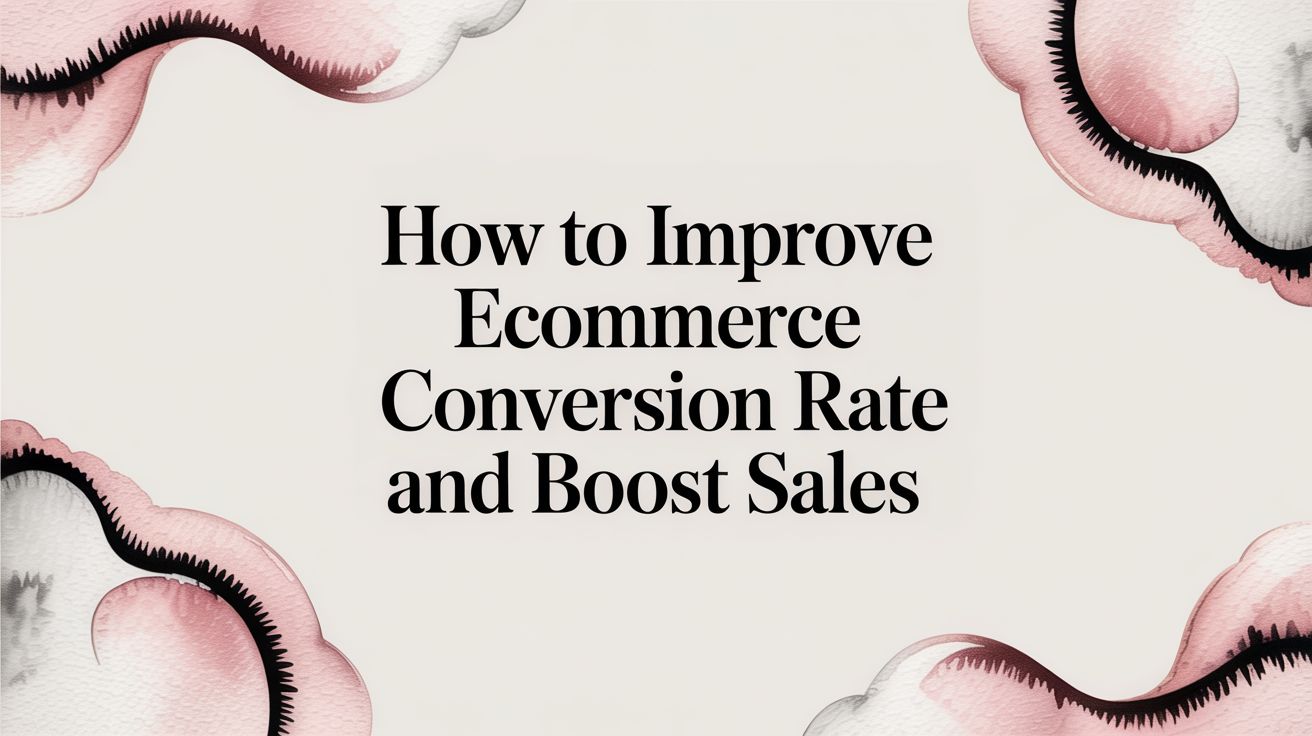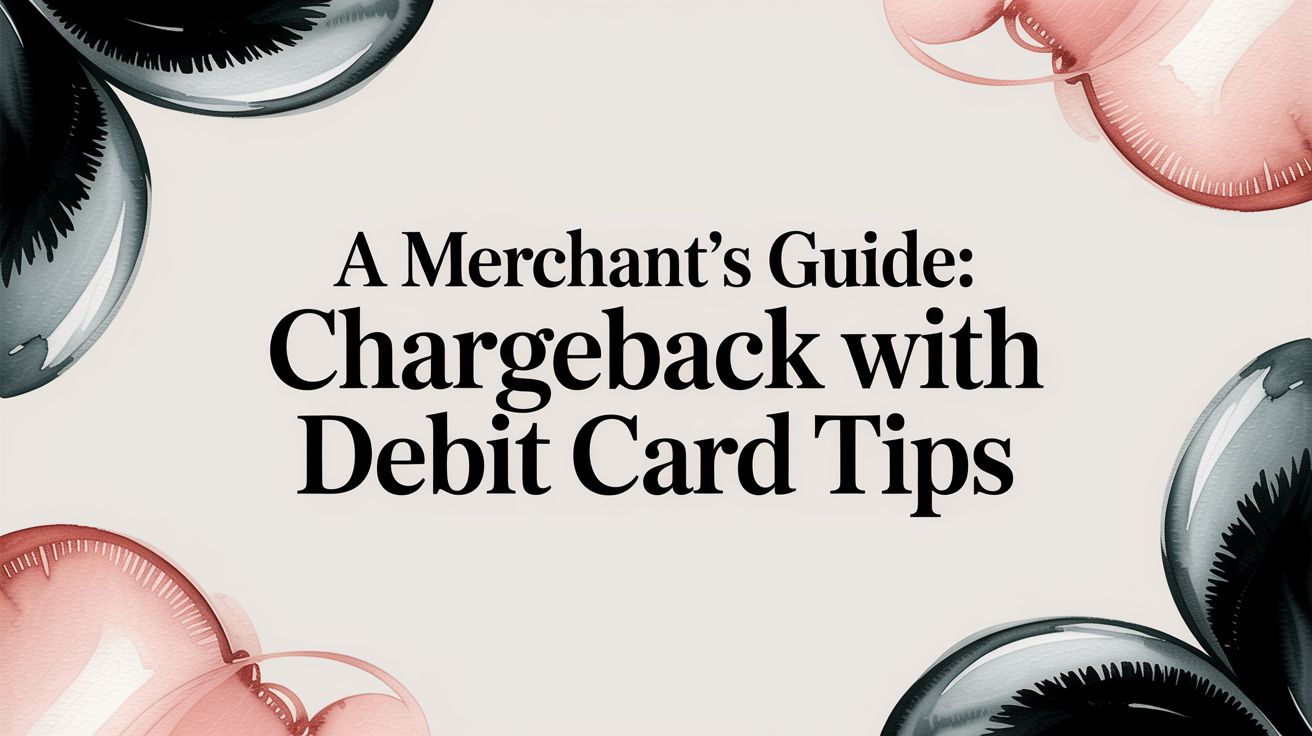
Merchant chargeback protection is a collection of services and tools built to stop payment disputes, fight back against bogus chargebacks, and ultimately, protect the money your business earns. Don't think of it as a single tool. It's more like a complete security system for your income.
What Is Merchant Chargeback Protection
Let’s skip the jargon. Imagine your business's revenue is a house. A standard payment processor is like the lock on your front door—it covers the basics. But genuine merchant chargeback protection? That's the modern security system with cameras, motion detectors, and a direct line to a response team.
It's a proactive game plan that doesn't just sit around waiting for trouble. Instead, it actively scans for threats, stops them before they can do any damage, and helps you get your money back if something slips through. This system isn't just about fighting disputes after they happen; it’s about preventing lost revenue from fraud, customer mix-ups, and costly mistakes right from the get-go.
Why It Is an Essential Defense
In today's world, chargebacks are far more than a simple annoyance; they are a serious, fast-growing threat to your bottom line. Global chargeback volumes are absolutely exploding. One report projects they will hit 261 million in 2025 and soar to 324 million by 2028. That's a huge 24% jump in just three years, with the financial damage expected to reach an eye-watering $41.7 billion. To get the full picture, you can check out the 2025 State of Chargebacks Report from Mastercard.
This screenshot from Chargeblast.com shows you exactly how modern protection services give you a clear dashboard to keep an eye on these threats.

The dashboard puts key numbers right in front of you, like win rates and recovered revenue, proving that solid protection is something you can measure and that it directly helps your business. Getting this is the first step toward keeping your business safe. For a deeper look, check out our guide on eCommerce chargeback protection.
Why Your Payment Gateway Is Not Enough
It’s a common—and expensive—misconception for business owners. You’ve set up a payment gateway like Stripe or PayPal and assume you’re covered from every angle. But relying only on your gateway for protection is like locking your front door while leaving all the windows wide open.
A payment gateway’s main job is to authorize and process transactions. Think of it as the essential toll booth that lets money move securely from your customer to you. It's not, however, a dedicated security force designed to fight for your revenue after the sale is done.

This is where dedicated merchant chargeback protection steps in. While your gateway might offer some basic fraud filters, a specialized service is built to handle the messy, complicated world of disputes long after the payment clears. It’s the difference between a simple padlock and a full-fledged security detail.
The True Cost of a Single Chargeback
A chargeback is never just about the lost sale. The financial sting cuts much deeper, creating a ripple effect that can seriously damage your business. Every single time a customer disputes a charge, you get hit with multiple costs.
The total financial damage from a single chargeback can be 2.4 times the original transaction value. This means a $100 dispute actually costs you around $240 when you factor in all the hidden expenses.
These extra costs pile up fast. Here’s a quick rundown of what you’re losing:
- The Original Sale Amount: That revenue is immediately yanked from your account.
- Chargeback Fees: Banks and processors add on non-refundable fees, usually between $20 to $100 per dispute.
- Operational Costs: Think of the hours your team wastes digging up evidence, writing responses, and just trying to keep track of the whole mess.
Losing this time and money is painful enough, but there’s an even bigger threat looming: the health of your merchant account itself.
The Danger of a High Chargeback Ratio
Every business that takes card payments is being watched by card networks like Visa and Mastercard. They track a critical number called your chargeback ratio—the number of chargebacks you get each month divided by your total transactions.
If this ratio creeps above the standard threshold, which is often as low as 0.9%, you’ll be flagged as a high-risk business. This can trigger serious penalties, from higher processing fees to mandatory reserve funds. In the worst-case scenario, they can shut down your merchant account entirely, leaving you unable to accept payments at all.
For merchants on specific platforms, like Shopify, understanding these platform-specific risks is vital. You can learn more in our guide on Shopify chargeback protection.
Bottom line? Your payment gateway is an indispensable tool for doing business, but it was never designed to be your primary defense against the growing threat of disputes. Real protection requires a focused strategy.
Understanding the Main Causes of Chargebacks
To build a solid defense against chargebacks, you first have to know what you’re up against. Not all disputes are created equal, and they generally boil down to three distinct sources. Each one requires a completely different strategy for effective merchant chargeback protection.
Think of it like being a detective at a crime scene. You can't solve the case until you understand the motive. The three main culprits you'll encounter are criminal fraud, simple merchant error, and the biggest offender of them all, "friendly fraud."
Criminal Fraud: The Obvious Threat
This is the one everyone immediately thinks of. Criminal fraud is just straightforward theft—a fraudster gets their hands on stolen credit card information and uses it to make an unauthorized purchase. Eventually, the real cardholder spots the bogus charge, reports it to their bank, and a chargeback is triggered.
While it's a serious threat, this type of fraud is often the easiest to catch if you have the right security tools in place. It’s the digital version of a burglar breaking in; it’s malicious, intentional, and clearly a crime.
Merchant Error: The Accidental Dispute
Sometimes, the problem actually starts in your own house. Merchant error is exactly what it sounds like: a chargeback that happens because of a mistake in your fulfillment or billing process. This could be anything from accidentally double-billing a customer to shipping out the wrong size or color.
Other common slip-ups include:
- An unclear billing descriptor that a customer doesn’t recognize on their statement.
- Forgetting to cancel a recurring subscription after a customer asked you to.
- A clunky or confusing return process that frustrates a customer so much they just file a dispute instead.
These are honest mistakes, but they can be incredibly costly. The key to preventing them is tightening up your internal processes. You can dig deeper into the specific reasons for a chargeback in our detailed guide.
Friendly Fraud: The Most Common Culprit
Here’s where things get tricky. Friendly fraud is, by far, the most widespread cause of chargebacks, and it happens when a legitimate customer disputes a purchase they actually made. It isn't always malicious; sometimes it's an honest mistake, like a teenager using their parent's card without permission.
More often than not, though, it happens out of convenience or buyer's remorse. This infographic really puts into perspective just how common friendly fraud has become.

The data is crystal clear: friendly fraud is responsible for half of all chargebacks, making it the single biggest threat merchants are up against. What's truly shocking is that 84% of customers admit it's just easier to file a chargeback than to ask for a refund. This behavior is on the rise, with some reports showing that 42% of Gen Z shoppers have done it.
Comparing Different Chargeback Protection Solutions
Choosing the right merchant chargeback protection isn't a one-size-fits-all deal. The best game plan for your business really boils down to your sales volume, how much risk you're dealing with, and frankly, how much time you can afford to sink into fighting disputes.
Let's walk through the most common solutions, starting with the old-school manual methods and working our way up to the seriously smart automated systems. Each has its own balance of cost, effort, and payoff. Figuring out these trade-offs is the key to building a defense that actually helps you, instead of just giving you more headaches.
Manual In-House Management
The most direct approach is just handling everything yourself. When a dispute notification lands in your inbox, it's on you or your team to start digging—pulling up order details, shipping confirmations, and customer emails to piece together a case.
This can work if you're a tiny business with just a handful of sales a month. But it gets out of hand fast as you grow. The time you spend fighting disputes is time you're not spending on marketing, sales, or just keeping your customers happy. It’s a bit like doing your business accounting with a paper ledger—sure, it's possible, but it's wildly inefficient and easy to mess up.
A single chargeback can eat up hours of admin time. As you get more disputes, this manual process often leads to missed deadlines and sloppy evidence, sending your win rates straight into the ground.
Preventative Tools and Fraud Filters
A solid step up from the DIY method is using preventative tools. Think of these as your front-line defense, designed to spot and stop sketchy transactions before they even go through.
Some of the most common tools you'll see are:
- Address Verification Service (AVS): This just checks if the billing address the customer typed in matches the one their bank has on file. Simple but effective.
- Card Verification Value (CVV): This is that little three- or four-digit code on the back of the card. Requiring it proves the customer likely has the physical card in their hand.
- Fraud Scoring: This is where things get a bit more advanced. These systems use algorithms to look at hundreds of little details—like the customer's IP address, their email history, or how big the order is—to assign a risk score to the transaction.
These tools are fantastic for catching obvious criminal fraud, but they don't do much against friendly fraud—where a real customer makes a legitimate-looking purchase and disputes it later.
Chargeback Alert Networks
Chargeback alerts give you a last-ditch chance to stop a dispute before it officially becomes a chargeback. Here's how it works: when a customer calls their bank to complain, an alert network pings you, giving you a 24-72 hour window to just issue a full refund.
This helps you dodge the chargeback fee and keeps your dispute ratio from getting out of control. The huge downside? You automatically lose the sale and all that revenue. It's a purely defensive move that gets really expensive if you're constantly refunding sales just to avoid disputes.
Fully Automated AI Platforms
Now we're at the top tier: a fully automated, AI-powered platform like ChargePay. This kind of service takes the entire dispute process off your plate, using technology to build and submit a rock-solid case for you.
For most businesses, this is the gold standard of merchant chargeback protection. For a deep dive into how this plays out on a specific payment gateway, our guide on Stripe chargeback protection has some great insights. These platforms plug right into your payment processor, automatically grab all the necessary data, and use machine learning to put together the strongest possible response. The result? You dramatically boost your win rate without lifting a finger.
Comparing Chargeback Protection Methods
To make it easier to see how these options stack up, let's put them side-by-side. Every business has different needs, and what works for a small startup won't be the right fit for a high-volume online store.
Ultimately, the goal is to find a solution that protects your bottom line without draining your resources. Whether you're just starting out or scaling quickly, understanding these different approaches will help you build a smarter, more effective defense against chargebacks.
How AI and Automation Are Changing the Game
Trying to manage chargebacks manually feels a lot like trying to bail out a sinking boat with a thimble. It's a soul-crushing, never-ending task where the odds are stacked against you from the start. But thankfully, technology—specifically AI and automation—is flipping the script, giving businesses a real chance to fight back and win.
Forget having a team member spend hours sifting through spreadsheets and order histories. An AI can scan thousands of transaction data points in the blink of an eye. It picks up on subtle, suspicious patterns a human would almost certainly miss, flagging high-risk orders before they can ever become fraudulent chargebacks. This is the new front line of merchant chargeback protection.

This proactive defense is huge, but the real magic kicks in after a dispute is already filed. This is where automated systems can step in and handle the entire representment process for you, from start to finish.
Smarter Evidence Gathering and Submission
Picture this: the moment a dispute hits your account, a system instantly pulls together all the evidence you need to build a rock-solid case. That’s exactly what AI-powered platforms do.
They grab all the compelling proof needed to shut down the dispute, including:
- Order Details: The system snags the customer's IP address, device info, and their purchase history with your store.
- Shipping Confirmations: It pulls up tracking numbers and delivery confirmations to prove the item made it to their doorstep.
- Customer Communications: It can even find past support tickets or email exchanges to show you made every effort to help the customer.
Once it has all the evidence, the system packages it into a professional, persuasive response that’s formatted perfectly for the specific reason code and bank requirements. This doesn't just save your team hundreds of hours; it eliminates the costly human errors that can sink an otherwise winnable case.
Automated chargeback systems don't just work faster—they work smarter. By analyzing data from millions of past disputes, they learn which evidence is most effective for each specific chargeback scenario, dramatically boosting win rates.
The Power of Predictive Analytics
Top-tier platforms like ChargePay use AI to do more than just react; they predict. By learning the ins and outs of your transaction patterns, these systems can identify which disputes are most likely friendly fraud and, more importantly, which ones you have the highest probability of winning.
This lets you take a much more strategic approach to fighting chargebacks. The technology can even make sense of unstructured text from customer complaints or notes from the bank, using techniques like Natural Language Processing. If you want to dig into the tech that makes this possible, check out this great resource on What Is Natural Language Processing.
By automating this entire complex process, you can transform chargeback management from a time-sucking cost center into a streamlined, revenue-recovering machine. To see how it all comes together, you might want to read our complete guide to automated chargeback and dispute management using AI. For any merchant serious about protecting their bottom line, embracing this technology is no longer just a nice-to-have—it’s essential.
Building Your Chargeback Protection Strategy
You don't have to break the bank to build a solid defense against chargebacks. An effective merchant chargeback protection plan starts with a few smart, preventative layers. The whole point is to stop disputes before they ever get started, making your business a much tougher target for both honest mistakes and outright fraud.
Think of what follows as your foundational checklist. These are simple, practical steps you can put into motion today. They're all designed to cut down on customer confusion and frustration—two of the biggest reasons chargebacks happen in the first place. It all boils down to crystal-clear communication.
Create Clarity and Trust
Honestly, the best way to stop disputes is to get rid of any and all surprises. When a customer feels like they're in the loop and being treated with respect, they're far less likely to call their bank when a problem pops up. Your first line of defense is simply making sure they know exactly what to expect from you.
Start by taking a hard look at these key areas:
- Billing Descriptors: Check what name shows up on your customer's credit card statement. A cryptic code like "SP*WEBSERVICES" instead of "YourBrandName" is a surefire way to trigger a "what's this charge?" dispute. Make it obvious it's you.
- Transparent Policies: Your return, refund, and shipping policies need to be dead simple to find and even easier to read. Ditch the legal jargon. Clearly state your timeframes, conditions, and what the customer needs to do.
- Accessible Support: Give customers multiple, obvious ways to get in touch. A phone number, an email address, or a live chat widget placed prominently on your site can catch a complaint long before it ever becomes a costly chargeback.
A proactive and transparent approach does more than just stop chargebacks; it builds trust. When customers know you're easy to reach and straight with them, they'll almost always choose to work with you directly to solve a problem.
A truly comprehensive strategy also involves playing the long game with strategies to build customer loyalty. Customers who feel a connection to your brand are more likely to give you the benefit of the doubt.
By nailing these preventative basics, you create an environment where disputes are far less likely to happen. It's a simple way to protect your bottom line without a massive, complicated investment.
Got Questions? We’ve Got Answers.
Still have a few things you're wondering about merchant chargeback protection? Let's clear up some of the most common questions we hear from business owners just like you.
What’s This Going to Cost Me?
The price tag on chargeback protection can swing quite a bit, depending on who you partner with and how they structure their fees. Some services charge a flat monthly rate, while others might take a cut of the revenue they successfully win back for you. You'll also see some that charge per dispute.
At first glance, a fully automated AI solution might look like the more expensive option. But when you factor in their sky-high success rates and the sheer amount of time you get back, the return on investment is often way better. They’re built to stop revenue leaks that other methods just can't plug.
Can I Just Do This Myself?
You absolutely can, especially when you're just starting out and only see a handful of transactions. If your dispute volume is low enough, manually keeping track of everything and submitting evidence is definitely manageable.
But here’s the thing: as your business grows, that manual approach gets out of hand fast. It becomes a huge time sink, and frankly, it's not nearly as effective. Professional services have the advantage of better data, automated systems, and the kind of deep expertise that dramatically boosts your odds of winning.
What's a Chargeback Ratio, and Why Should I Care?
Think of your chargeback ratio as a critical health score for your business. It's a simple formula: the number of chargebacks you get in a month divided by your total number of transactions for that same month.
The card networks, like Visa and Mastercard, are always watching this number. If it creeps over their accepted threshold—which is often around a tiny 0.9%—your business gets flagged as high-risk. That can bring on heavy fines or, in a worst-case scenario, get your merchant account shut down completely.
Ready to stop watching your hard-earned revenue walk out the door? ChargePay puts AI to work, automating the entire dispute process to boost your win rate and free up your time. Protect your business and get your money back today.







.svg)







.svg)
.svg)
.svg)